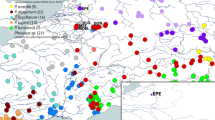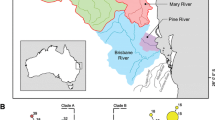Abstract
There has been controversy over the species status of Sonoran topminnows and debate about the presence of ESUs in the Gila topminnow. From examination of sequence variation at 2626 base pairs over three mtDNA genes, we found a 29 (1.1%) nucleotide genetic difference between Gila and Yaqui topminnows. This provides strong support that these two taxa are separate species, Poeciliopsis occidentalis (Gila topminnow) and P. sonoriensis (Yaqui topminnow) and have been separated for approximately one million years. All the Gila topminnows within Arizona have the same sequence for the three mtDNA genes, that is, there is not reciprocal monophyly for mtDNA sequence data for the two previously designated ESUs. However, evidence of the unique habitat for Monkey Spring, its long-term isolation from other Gila topminnow habitats, and the presence of unique fish and invertebrate taxa in Monkey Spring support the designation of the Monkey Spring topminnows as an ESU. Finally, theoretical considerations using molecular data and estimates of heterozygosity and genetic distance for nuclear genes between populations of the Gila topminnow show that the lack of mtDNA variation is not inconsistent with the level and pattern of nuclear genetic variation observed.
Similar content being viewed by others
References
Bermingham E, McCafferty SS, Martin AP (1997) Fish biogeography and molecular clocks: perspectives from the Panamanian Isthmus. In: Kocher TD, Stepien CA (eds). Molecular Systematics of Fishes. Academic, San Diego, pp. 113–128
Broughton RE, Milam JE, Roe BA (2001). The complete sequence of the zebrafish (Danio rerio) mitochondrial genome and evolutionary patterns in vertebrate mitochondrial DNA. Genome Res. 11:1958–67
Cardwell T, Sheffer RS, Hedrick PW (1998) Male development in the endangered Gila topminnow. J. Hered. 89:353–355
Chakraborty R, Nei M (1977) Bottleneck effects on average heterozygosity and genetic distance with the stepwise mutation model. Evolution 31:347–356
Coyne JA, Orr HA (1989) Patterns of speciation in Drosophila. Evolution 43:362–381
Crandall KA, Bininda-Emonds ORP, Mace GM, Wayne RK (2000) Considering evolutionary processes in conservation biology. Trends Ecol. Evol. 15:290–295
Dowling TE, Tibbetts AC, Minckley WL, Smith GR (2002) Evolutionary relationships of the Plagopterins (Teleostei: Cyprinidae) from Cytochrome b sequences. Copeia 2002:665–678
Fraser DJ, Bernatchez L (2001) Adaptive evolutionary conservation: towards a unified concept for defining conservation units. Molec. Ecol. 10:2741 2752
Glavac DM, Dean M (1993). Optimization of the Single-Strand Conformation Polymorphism (SSCP) technique for detection of point mutations. Hum. Mut. 2:404–414
Hall T (1991–2004) BioEdit Sequence Alignment Editor. Isis Pharmaceuticals, Inc
Hedrick PW (1999) Perspective: highly variable loci and their interpretation in evolution and conservation. Evolution 53:313–318
Hedrick PW (2005) Genetics of Populations, 3rd Edition. Jones and Bartlett, Boston
Hedrick PW, Parker KM (1998) MHC variation in the endangered Gila topminnow. Evolution 52:194–199
Hedrick PW, Parker KM, Lee R (2001) Genetic variation in the endangered Gila and Yaqui topminnows: microsatellite and MHC variation. Molec. Ecol. 10:1399–1412
Hughes J, Ponniah M, Harwood D, Chenoweth S, Arthington A (1999) Strong genetic structuring in a habitat specialist, the Oxleyan Pygmy Perch Nannopera oxleyana. Heredity 83:5–14
Hurt, CR (2004) Genetic divergence, population structure and historical demography of rare springsnails (Pyrgulopsis) in the lower Colorado River basin. Molec. Ecol. 13:1173–1187
Hurt CR, Stears-Ellis S, Hughes K, Hedrick PW (2004) Mating behavior in the endangered Sonoran topminnow: speciation in action. Anim. Behav. 67:343–351
Hurt CR, Hedrick PW (2003) Initial stages of reproductive isolation in two species of the endangered Sonoran topminnow. Evolution 57:2835–2841
Hurt CR, Farzin M, Hedrick PW (2005) Premating, not postmating, barriers drive genetic dynamics in experimental hybrid populations of the endangered sonaran topminnow. Genetics, in press
Kumar S (1996) PHYLTEST: Phylogenetic hypothesis testing software. Version 2.0. Pennsylvania State University, University Park, Pennsylvania
Kumar S, Tamura K, Jakobsen IB, Nei M (2001) MEGA2: Molecular Evolutionary Genetics Analysis software. Arizona State University, Tempe, Arizona
Li WH (1976) Electrophoretic identity of proteins in a finite population and genetic distance between taxa. Genet. Res. 28:119–127
Mateos M, Sanjur OI, Vrijenhoek RC (2002) Historical biogeography of the livebearing fish genus Poeciliopsis (Poeciliidae: Cyprinodontiformes). Evolution 56:972–984
Melton MA (1960) Origin of the drainage of southeastern Arizona. AZ. Geol. Soc. Digest 3:113–122
Minckley WL (1973) Keys to native and introduced fishes of Arizona. J. Ariz. Acad. Sci. 6:183–188
Minckley WL (1999) Ecological review and management recommendation for recovery of the endangered Gila topminnow. Great Basin Natur. 59:230–244
Moritz C (1994) Defining “evolutionarily significant units” for conservation. Trends Ecol. Evol. 9:373–375
Moritz C (2002) Strategies to protect biological diversity and the evolutionary processes that sustain it. Syst. Biol. 51:238–254
Nei M (1987) Molecular Evolutionary Genetics. Columbia University Press, New York
Parker KM, Sheffer RJ, Hedrick PW (1999) Molecular variation and evolutionarily significant units in the endangered Gila topminnow. Cons. Biol. 13:108–116
Quattro JM, Leberg PL, Douglas ME, Vrijenhoek RC (1996) Molecular evidence for a unique evolutionary lineage of endangered Sonoran desert fish (genus Poeciliopsis). Cons. Biol. 10:128–135
Sheffer RJ, Hedrick PW, Velasco AL (1999) Testing for inbreeding and outbreeding depression in the endangered Gila topminnow. Anim. Cons. 2:121–129
Stepine CA, Dillion AK, Brooks MJ, Chase KL, Hubers AN (1997) The evolution of blennioid fishes based on an analysis of mitochondrial 12S rDNA. In: Kocher TD, Stepien CA (eds). Molecular Systematics of Fishes. Academic, San Diego, pp. 245–270
Takezaki N, Razhetsky A, Nei M (1995) Phylogenetic test of the molecular clock and linearized trees. Mol. Biol. Evol. 12:823–833
Vrijenhoek RC, Douglas ME, Meffe GK (1985) Conservation genetic of endangered fish populations in Arizona. Science 229:400–402
Waples RS (1995) Evolutionarily significant units and the conservation of biological diversity under the Endangered Species Act. Amer. Fish. Soc. Symp. 17:8–27
Acknowledgments
We appreciate the financial support from the Arizona Heritage Fund and the Ullman Professorship for this research. We appreciate comments on an earlier version of this manuscript from two anonymous reviewers.
Author information
Authors and Affiliations
Corresponding author
Rights and permissions
About this article
Cite this article
Hedrick, P.W., Lee, R.N. & Hurt, C.R. The endangered Sonoran topminnow: Examination of species and ESUs using three mtDNA genes. Conserv Genet 7, 483–492 (2006). https://doi.org/10.1007/s10592-005-9058-9
Received:
Accepted:
Published:
Issue Date:
DOI: https://doi.org/10.1007/s10592-005-9058-9




